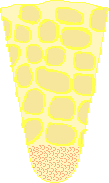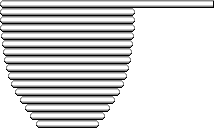| |
Induced or Forced Supersedure In Honey Bees
Methods by which the bees may be encouraged or induced into producing a
replacement queen without swarming.
Much of this text has been written by my friend Ken Hoare,
the illustrations and layout can be blamed on me.
The most sure-fire method of requeening a colony is to find
the old queen and cull her. Then a nucleus or full-size colony with a
mated and laying queen can easily be united, with a 99.9% chance of success.
|
|---|
But there will be times when a colony needs re-queening and
it proves difficult to find the old queen. There could be several
reasons, most likely inexperience of the beekeeper, aggressive nature
of the bees, the number of bees present within a brood
box or possibly multiple brood boxes.
Recent posts on the Irish bee list discussion group has suggested a system
known as 'Virgin Drop' could re-queen a colony without the need to
find the old queen. In the simplest of terms a colony is heavily
smoked at the entrance and a virgin queen which has had no contact
with other bees, i.e. a queen 'pulled' from a cell, or a queen raised
in an incubator, is dropped into the top of the hive. This is a
system practised in New Zealand and the Americas with, I understand,
a good success rate. A commercial beekeeper in the United Kingdom
has stated he didn't experience the same, in fact, he had high losses
when using virgin drop. So possibly the strain of bee can influence
the outcome, the lighter strains being easier to introduce. The loss
of introduced queens might be acceptable to some commercial beekeepers
(time is money syndrome and in New Zealand and America virgin queens
are easily and cheaply available), but generally the UK hobbyist
beekeeper will be unhappy to tolerate any loss of introduced queens.
As long ago as 1992, the Devon Apicultural Research Group members
decided to test Induced Supersedure and generally the results were very favourable.
I have already mentioned, and believe it is common
knowledge, that before introducing a new queen into a colony it is
necessary to find the old queen and remove her. Otherwise, any
introduced mated or virgin queen will be destroyed. An unprotected
queen cell placed into a hive where a queen is present will normally
be destroyed by one side of the cell being broken down. But if this
cell is protected, there is a good chance of successful introduction,
both original and new queen will be present and one will be killed or
starved, but eventually ejected from the hive, which are the natural
supersedure instinct of the honey bee.
Unless the original queen is marked, it will be impossible
to discover if the new queen from the cell has been accepted in
favour of the original queen, well nigh impossible, other than a noticeable
change of colour of later workers. Consequently, in order to prove the
success of the method to yourself, I recommend every effort is made to
find and mark the old queen.
|
The method of inducing supersedure is simple. Cells can be
from many sources, swarm cells, cells from grafted larva, cells
produced using a Jenter type cage, all can satisfactorily be used.
If possible, the tip of the cell should be 'bronzed' (as the one
illustrated at right indicates "bronzing"), meaning that it
is maybe one to three days away from emergence. I cannot emphasise
enough the necessity of treating these cells gently and keeping them
upright. Laying them on their sides at this stage can result in a
damaged queen. It should not be difficult to bore suitable size holes
into a block of polystyrene or florists 'Oasis' block into which the
cells can be held upright, pending introduction into a hive.
| |

|
|---|
|
The sides of the queen cell must be protected, otherwise, as
previously stated, it is likely they will be torn down. Protection
can be as simple as aluminium kitchen foil wrapped around the sides
of the cell, or possibly cone shapes can be cut from the neck of, say,
shampoo bottles, or purpose-made
'cell protectors' are
available from the appliance dealers. These exist in many types, the
commonest is made from spiral wound wire (as right), with a plate at
the top, which prevents access to the cell from the top end and a short
length of the wire which easily pushes into the comb to fix it in position.
| |

|
|---|
In use, the protected cell is fixed into the face of a brood
comb, the central area of the comb is best. In the United Kingdom,
probably most of the Northern Hemisphere, July will be the best month
to introduce protected cells, as this will be about the time that
normal supersedure's take place. Having introduce the protected cell
into the colony, the hive is closed and left for about one month. By
this time the new queen, if she has been accepted, will be mated and
laying and the old queen is unlikely to be present.
The success rate of the method is greatly increased if the
queen to be replaced is in at least her second season.
But if the system has failed, I always think the 'angry'
stocks are the most difficult to re queen, well nothing will be lost.
The original queen will still be present and you will be left to
discover an alternative way of requeening.
Ken Hoare
Ken has written the above from a knowledge base that has a
Southern England bias... I would further comment that the timings can
be about a fortnight later if you are North of Northampton and that
in these more northerly areas it is quite common for a period of side
by side laying of the old and new queens.
Failure rates given above are not actually as bad as pure
numbers may suggest. There may well be defects in the virgin that only
the bees are capable of properly determining. In these cases the
original queen will be retained by the bees and so although the
result is "a failure" from the point of view of requeening,
it is actually to the bees advantage (and thus the beekeeper's as well).
As a result of wide differences in percentages for
effectiveness, reported from different parts of the world, Ken has
suggested a trial that can
easily be instigated by hobby beekeepers.
Dave Cushman.
Page created 29/01/2002
Page updated 28/12/2022
Page Generated... 29 January 2002,
Revised... 22 January 2003,
Upgraded... 15 June 2006,
|

